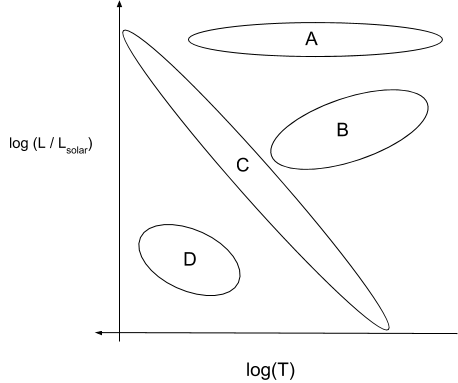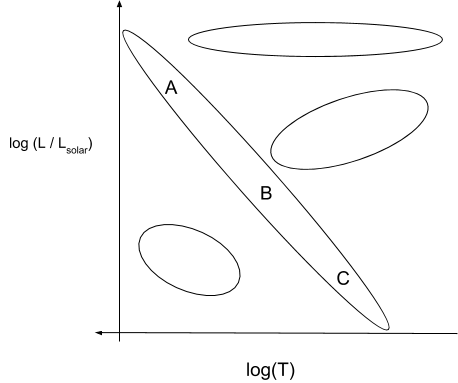uplearn stars
1/62
There's no tags or description
Looks like no tags are added yet.
Name | Mastery | Learn | Test | Matching | Spaced |
|---|
No study sessions yet.
63 Terms
definition of a planetary satellite
A body in orbit around a planet, including moons and man-made satellites
comet
Small, irregular bodies made up of dust, ice, and small pieces of rock, which orbit the sun in highly elliptical orbits
solar system
A solar system is the collective name for a star and all the objects that orbit that star, including planets, comets, and asteroids
galaxy
A galaxy is a collection of stars, interstellar dust and gas
universe
The universe is everything — from matter to energy and all of space-time
Planet
an object that orbits around a star and must: 1) Have a large enough mass for its own gravity to give it a round shape; 2) have no fusion reactions; 3) have cleared its orbits of most other objects
nebula
Huge clouds of dust and gas, where stars are born
Nebulae are formed over million of years as dust and gas slowly come together due to gravitational attraction to form vast clouds. Identify how these clouds begin to collapse to form stars.
Some regions in the nebula cloud are denser than other regions, and the cloud collapses around these denser regions
Taking a single dense region and thinking about the gravitational collapse in that region, select the statement that describes what happens in terms of energy when the collapse takes place.
Work is done by gravity, causing the gravitational potential energy to decrease and the kinetic energy of the gas and dust to increase
When regions of nebula collapse, work is done by gravity. The gravitational potential energy decreases and the kinetic energy of the gas and dust increases. Identify how these changes affect the temperature of the region.
The temperature increases because temperature is proportional to the average kinetic energy of the gas and dust particles
State the name for a very dense and very hot sphere of dust and gas in which nuclear fusion has not taken place
protostar
Nuclear fusion does not occur within protostars. Identify the statement that correctly describes what happens after a protostar is formed.
Some protostars begin nuclear fusion and develop into stars, others don’t
If a protostar has high enough temperature and pressure, nuclear fusion occurs. Identify the nuclei that are fused in this initial nuclear fusion.
Hydrogen nuclei fuse to form helium nuclei
The temperature and pressure inside a protostar determines whether nuclear fusion begins. Identify why a high temperature and pressure is needed for nuclear fusion to begin
In order to overcome the electrostatic repulsion between hydrogen nuclei
Identify what determines whether the temperature and pressure inside a protostar reaches the required level for nuclear fusion to begin
The amount of mass in and immediately around a protostar
Relative to a star’s complete life-span, how long does a star remain at almost a constant size due to the equilibrium between the gravitational forces and the gas and radiation pressures?
For the majority of the star’s life cycle
describe why the star core’s mass determines the length of stability
The higher the core’s mass, the hotter the core. This increases the rate of hydrogen fusion
solar mass
The mass of the Sun
Identify the mass range of low-mass stars.
0.5 — 10 solar masses
Stars are on the main sequence for most of their lifespan. After a very long time on the main sequence, a significant change takes place within stars. Identify the cause of this change
The hydrogen in the star’s core begins to run out
What happens to the star’s core once hydrogen levels in the core start to deplete?
The core collapses slightly
Following the depletion of core hydrogen, the core collapses a bit. Identify what happens next in low-mass stars at this stage
The pressure in the core increases, which triggers hydrogen burning in the shell around the core
A low-mass star will undergo the following phases after it’s hydrogen levels in the core start to deplete:
∘∘ The core collapses a bit
∘∘ The pressure increases, but the temperature is not high enough to start helium burning in the core
∘∘ Hydrogen burning begins in the shell around the core due to the increased pressure
What is the effect of the shell hydrogen burning in low-mass stars?
The shell hydrogen burning pushes the outer layers of the star away from the core, creating a red giant
A low-mass star expands into a red giant when hydrogen burning in the shell around the core takes place. Identify how the surface temperature of the star changes.
The surface temperature decreases as the star expands
Identify what eventually happens to the layers of a red giant outside the core
The layers are pushed away to form a planetary nebula
White dwarf
A very dense inert core (no fusion taking place) of a red giant, left over when the outer layers of the red giant have been pushed away
A white dwarf is the remnant part of the star once the outer layers of a red giant are pushed away. Identify the correct statement regarding the temperature and fusion activity of a white dwarf
The temperature of a white dwarf is very hot, and can be up to 30000 K. No fusion takes place within a white dwarf
Identify the statement that correctly describes the density, mass and volume of a white dwarf
White dwarfs have high density, commonly with a volume equal to the Earth, and mass equal to the Sun’s mass
Identify what stops complete gravitational collapse in some white dwarfs
Electron degeneracy pressure
The electron degeneracy pressure can only stop further gravitational collapse if the core has mass below a certain limit. identify the value of this limit in solar masses.
1.44 solar masses
Red giant
An expanding star that has an inert core with no fusion taking place, but a shell around the core in which light elements are undergoing fusion
Chandrasekhar limit
The mass of a star’s core below which the electron degeneracy pressure will prevent gravitational collapse. The Chandrasekhar limit is 1.44 solar masses
A massive star is defined as a star that has a mass greater than:
10 solar masses
Identify the correct statement about massive stars when they are in the main sequence phase
Main sequence massive stars use up their hydrogen quickly, so life span is often only millions of years
What happens to massive stars when hydrogen in core runs out?
The cores begins to collapse much like low mass stars
describe the change in the kinetic energy and the temperature of a high mass core compared to a low mass core when the core begins to collapse.
The kinetic energy and the temperature of the core increases more than for low mass cores
As the core collapses the temperature of the core is sufficient in cores for helium to overcome the electrostatic repulsion.
Name the nuclear reaction that will take place between helium nuclei
fusion
As the core collapses, fusion of helium starts.
Select the the option that identify the requirement for the fusion of helium to start
The temperature of the core is sufficiently high to overcome the electrostatic repulsion
The helium fusion causes the star to enter a new stage.
Select all the correct characteristics of this new stage.(2)
The star becomes a red supergiant
The star expand
Progressively more massive nuclei in the core begin to fuse in the star.
Choose the option that correctly describes the structure of the star at this stage
All the new elements are distributed in a series of fusion layers
Progressively more massive nuclei in the core begin to fuse in the star, creating a series of fusion layers.
Identify all the elements from below that undergo fusion in the core during the red supergiant phase
helium
carbon
oxygen
Identify the heaviest element that can be created in the core
iron
describe what takes place in a non-burning iron core
There is a decrease in radiation pressure, which allows gravitational collapse to occur
In a non-burning iron core, there is a decrease in radiation pressure which allows gravitational collapse to occur.
Identify the next stage of the star
Type II supernova
Identify the type of star that a star will become after the supernova stage if the mass of star core is greater than 1.44 solar masses (chandrasekhar limit) but below 3 solar masses
neutron star
A neutron star is very different from a main sequence star. Choose all the correct characteristics of a neutron star (3)
Neutron stars are almost entirely made up of neutron
Neutron stars are incredibly dense
Electrons and protons combine to form neutrons
Identify the type of star that a star will become after the supernova stage if the mass of star core is greater than 3 solar masses
black hole
Identify all the correct statements about black-holes(2)
not even light can escape black holes
super-massive black holes are thought to be at the centre of galaxies
In the universe elements heavier than iron can be found.
At which stage are those elements formed?
supernova
Red supergiant
a massive star in the last stages of its life. Fusion of elements larger than hydrogen are taking place inside the star’s core
Supernova
an implosion of a red supergiant following the formation of sufficient iron in its core. The outer core and outer layers bounce off the inner core and are ejected into space, leaving an inert remnant core
Neutron star
following a supernova, if the remnant core is above the Chandrasekhar limit (1.44 solar masses) and below 3 solar masses, then a neutron star is formed after gravitational collapse. A neutron star consists almost entirely of neutrons and is extremely dense
Black hole
following a supernova, if the remnant core is above 3 solar masses, then gravitational collapse continues until the escape velocity is greater than the speed of light. Not even photons can escape a black hole
solar luminosity value
3.85×1026W
luminosity
the total radiant power output of a star
The Hertzsprung-Russell diagram is a useful way to compare the luminosity (L) and the temperature (T) of different stars.
Which of the diagram below shows the correct axes of the Hertzsprung-Russell diagram?

Identify the region that best represent the main sequence on the Hertzprung-Russell diagram below.

C
Identify the region that best represent the giants on the Hertzprung-Russell diagram below..

A, B
Identify the region that best represent the supergiants on the Hertzprung-Russell diagram below.

A
Identify the region that best represent the white dwarfs on the Hertzprung-Russell diagram below.

D
The Sun is a main sequence star.
Which of A, B or C best represents the position of the Sun on the H-R diagram.

B
The Sun is main sequence star.
∘∘ The Sun is located around the middle of the main sequence, with a surface temp of ~6000 K.
Choose the option that best represent the evolutionary path of a low mass main sequence star (like the Sun).
A low mass stars (like the Sun) move off the main sequence.
∘∘ Onto the giants branch as they expand, become more luminous and the outer layers cool.
∘∘ Then down to the white dwarfs as the cooler outer layers are lost.

Choose the option that best represent the evolutionary path of a high mass main sequence star.
High mass main sequence stars are located at the top of the main sequence.
∘∘ High mass stars move along the top from the top-left of main sequence to the supergiants sections.
∘∘ At which point they go supernova
